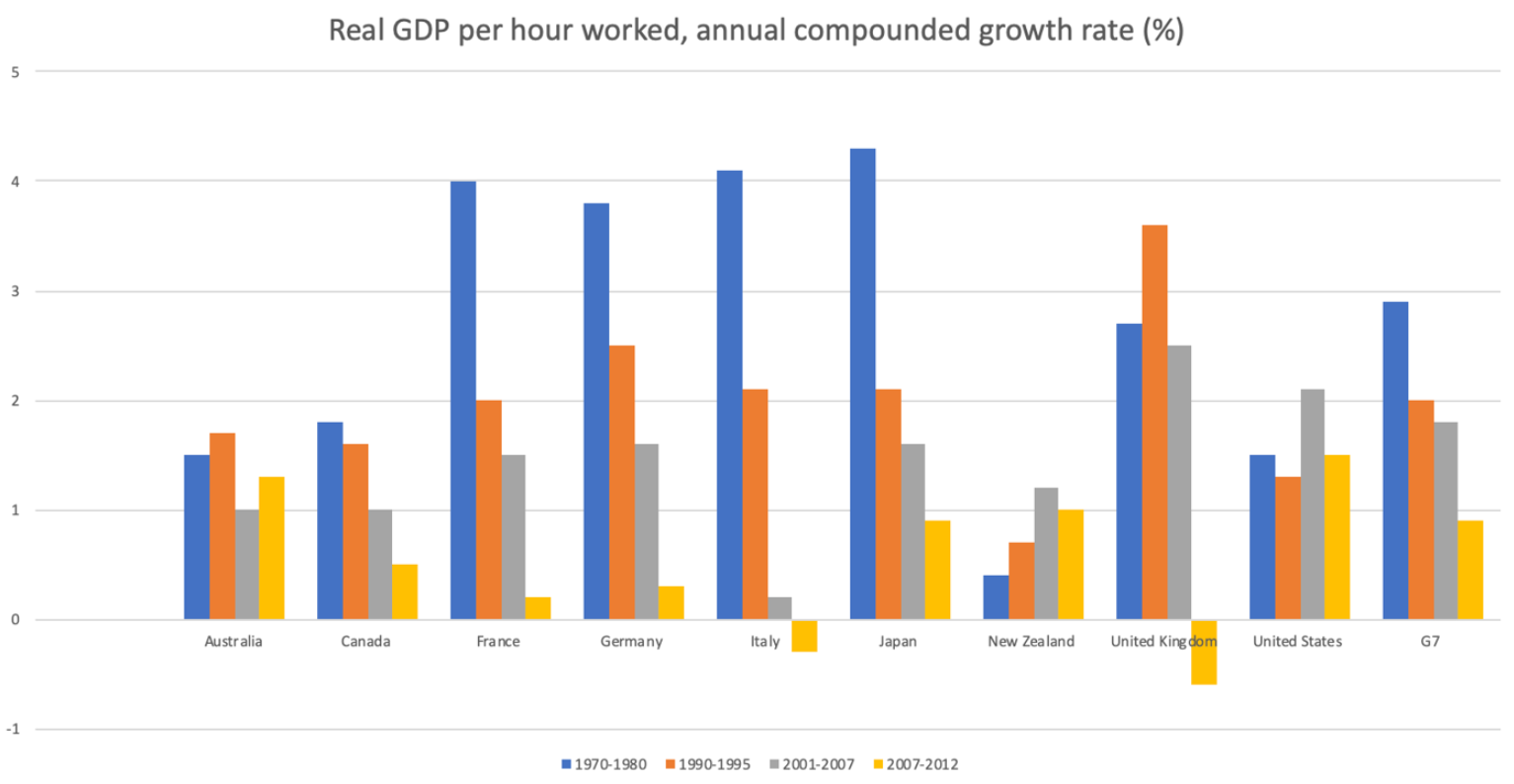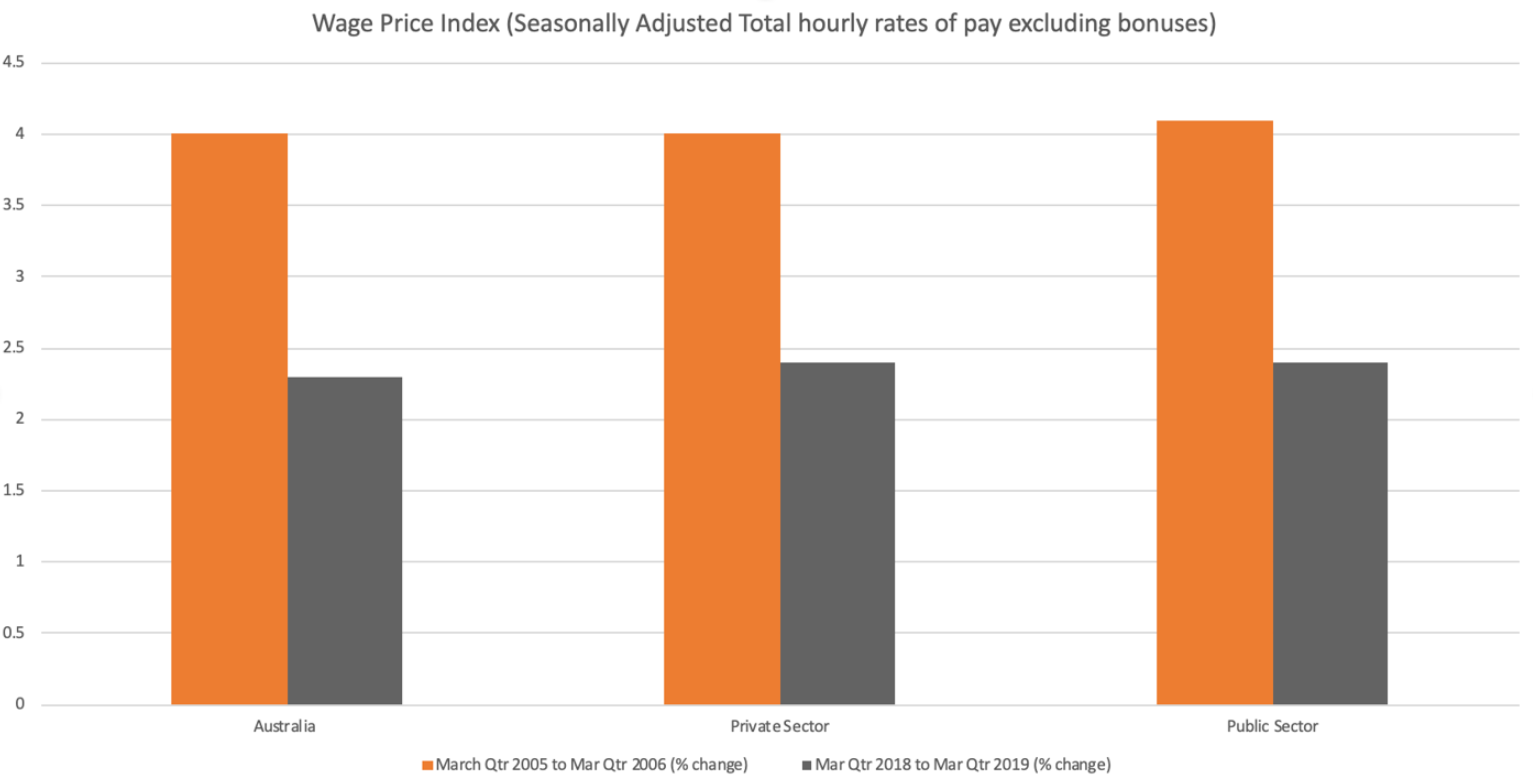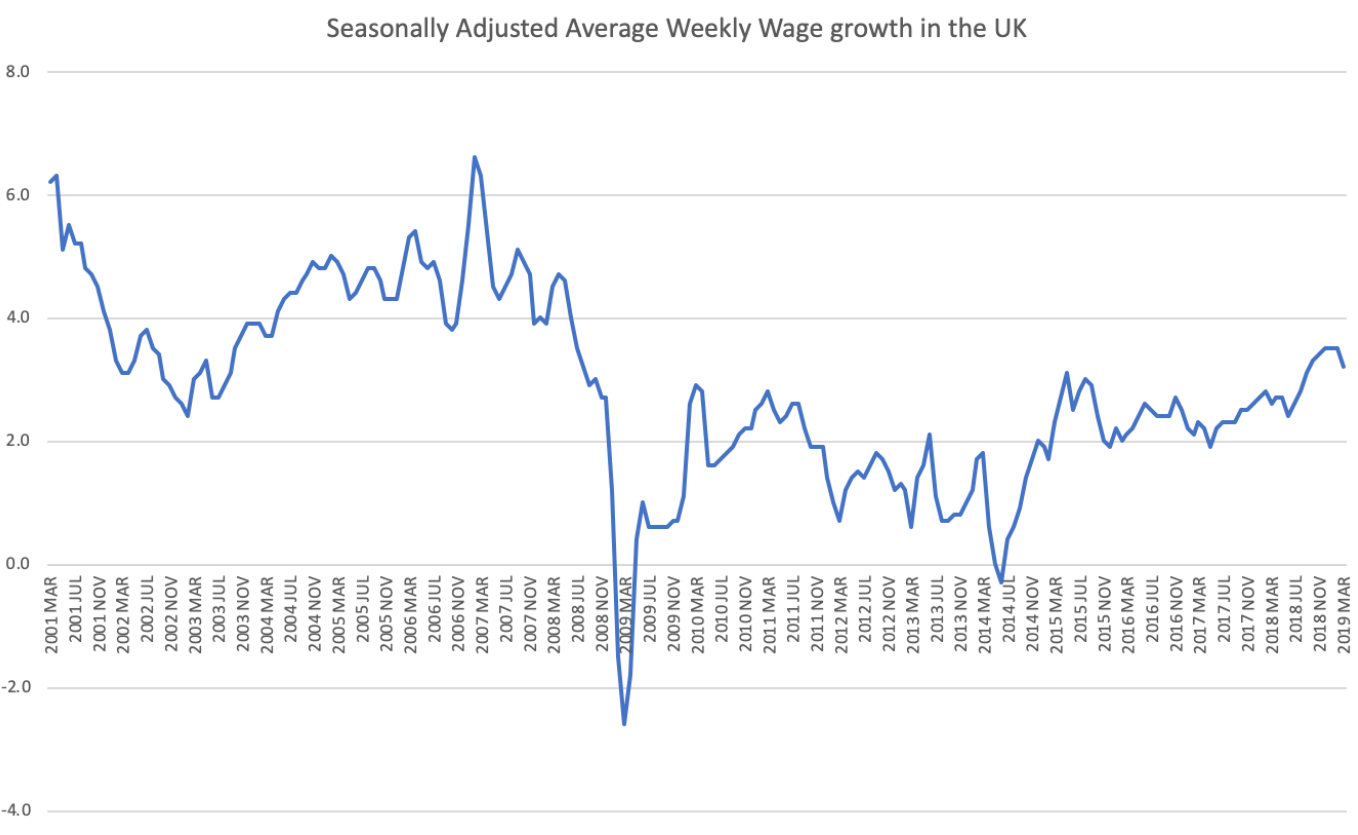
| Version | Summary | Created by | Modification | Content Size | Created at | Operation |
|---|---|---|---|---|---|---|
| 1 | Vivi Li | -- | 1986 | 2022-11-17 01:37:16 |
Video Upload Options
Wage growth (real wage growth) is a rise of wage adjusted for inflations, often expressed in percentage. In macroeconomics, wage growth is one of the main indications to measure economic growth for a long-term since it reflects the consumer's purchasing power in the economy as well as the level of living standards. An increase in wage growth implies price inflation in the economy while a low wage growth indicates deflation that needs artificial interferences such as through fiscal policies by federal/state government. Minimum wage law is often introduced to increase wage growth by stimulating price inflations from corresponding purchasing powers in the economy. Wage growth can also be maximised through the development of industry factors by investing skilled workers in which decision made by businesses. More financial compensation for skilled workers not only lifts wage growth but stimulates higher market prices in the economy. While a weak productivity influences a low wage growth, identified a long-term factor, a short-term problem for low wage growth is often identified as the spare capacity in the labour market. By the lower unemployment rate given by the more opportunities from the spare capacity in the labour market creates less competitiveness amongst the labours, which reduces wage growth. In order to achieve consistent strong wage growth and sustainable economic growth, high productivity is the key determinant. Higher labour productivity (measured by GDP per worker) stimulates price inflations in resulting in a rise in real wage growth. One of the major factors for the recent sluggish wage growth in advanced countries is caused by their lower labour productivities.
1. Overview

The recent trend of wage growth began in the 1800s due to the significant technological improvement (known as Industrial Revolution) as well as the growing size of the labour force in which phrase is known as the Solow phrase based on Solow's growth model in 1956.[2] As a result of the improvements, labour productivity in businesses has significantly increased resulting in a rapid rise in the wage growth in most of the advanced countries. However, this economic trend has dramatically changed since many countries have experienced low wage growth due to the Global Financial Crisis (GFC) in 2008. Although the attempt to recovering GDP and achieving lower unemployment rates in advanced countries after the GFC, many countries are still experiencing low wage growth rates. The International Labour Organisation reported that global wage growth has been slowing down reaching the lowest growth rate from 2.4 per cent in 2016 to 1.8 per cent in 2017[3] claiming that in spite of the recently increased investment in capital, the weak labour productivity has been the main issue that contributes to the current sluggish GDP resulting in the low wage growth.[4] Generally, low productivity growth and increased global competition have been identified for the recent slow wage growth, which prevents from sustainable economic growth.[5] The Economic Policy Institute reports that the current sluggish wage growth and lower labour productivity are driven by the abandonment of full employment as more flexible employment styles have become accepted due to the significant progress in automation, technological change and increasing global production integration.[6] Lower labour productivity results in a weak investment into capitals describing the lower total factor productivity growth.[6] Businesses often attempt to increase their efficiency (known as multifactor productivity) by increasing their shares into capitals, however, the economic impacts contribute to the employers whilst the employees experience fewer impacts from the investment. Wage growth is not necessarily impacted by fluctuations in unemployment rates however, it depends on how the wage growth is measured in calculations.[6]
1.1. Arguments
- The unemployment rate does not necessarily indicate the conditions of wage growth as it does not demonstrate accurate availability of jobs opportunities in the labour market. For example, the United States achieved full employment while experiencing low wage growth.[7]
- High wage growth does not represent high living standards assuming that the cost of living is high.[4]
- Inflation might not be affected by a high wage growth if profits go to the compensation for wages where they should be used to increase labour productivity.[4]
2. Measurement
Wage growth can be calculated in multiple ways. The measuring is often conducted by either from the producer perspective or from the consumer perspective.[8] While the producers calculate their labour costs relative to the output price (real producer wage) while the consumers calculate their wage associated with market prices (real consumer wage).[8] The examples include
- Which workers to include in the calculation... Employees this year might not be in the labour market next year or changed to different jobs. This method doesn't show accurate data of wage growth of the people as it is unclear if the wage has become higher or different people have joined in the labour market.[8]
- Calculating low-paid and high-paid workers equally... Although it estimates the living standards of an average worker, it is hard to determine the real wage growth due to the possible correlation with the inflation rate.[8]
- Calculate the Wholesale Price Index (WPI) deflated by Consumer Price Index (CPI)... This calculates the consumer perspective of wage growth as it observes the price inflations.[4]
Most of the countries examine their wage growths by adjusting the growth with respect to inflations, and this estimates real wage growth. In Australia, a gross monthly wage is used to calculate the real wage growth, adjusting relative to inflations as its variations reflect both hourly wages and the average number of hours worked.[4]
3. Trends
3.1. Australia

Despite the growing labour productivity in the recent five years, Australia has been experiencing stagnated wage growth in both the public and private sectors along with the global low-wage growth compared to the data in pre-GFC.[4] The Treasury Australia argues that the recent flexible work style has contributed to the recent stagnated wage growth.[4] As a result of increasing jobs in the service industries, more employment in part-time and non-routine jobs were created that affected the labour share of income. The Household Income and Labour Dynamics in Australian survey (HILDA) stated, “workers with a university education had higher wage growth than those with no post-school education over the period 2005-2010, but have since experienced lower wage growth than individuals with no post-school education.” [4] This can be explained as the introduction of minimum wage law not only creates slow growth in creating low-skilled jobs but also reduces the wage growth for high-paid workers due to the compensation for paying increased the minimum wages for the low-paid workers.[10]
3.2. The United Kingdom

Like the other advanced countries, the United Kingdom had the record low wage growth of -2.60 per cent in 2009 from the GFC, yet the wage growth has been slowly improving in recent years and has recovered to 3.5 per cent in 2019.[12] However, Britain is one of the worst countries with weak wage growth over the past decade compared to other OECD countries since the unemployment rates do not meet with the appropriate wage growth, calculated based on Phillips curve. In fact, 4 per cent of unemployment rate reflected a 5 per cent rise of wage growth in the 1980s despite the 2.9 per cent in 2018 with the same unemployment rate.[13]
With the low unemployment rates, one of the factors for the recent rise in wage growth includes more employment of disabled people and people in high skilled occupations, constructing a strong labour market.[12] By bringing more people into the workforce in high-paid occupations, it produces more competitiveness in the workforce resulting in the creation of higher labour productivity hence a high wage growth. Since self-employment has increased its employment by 15% in 2017, more flexibility in employment, entrepreneurship and more labour participation became available to workers.[14] However, since the weakness of self-employment produces relatively less labour productivity compared to bigger businesses, it could also contribute to the weak wage growth so that fiscal policies to secure the growth need to be conducted for long-term growth.[15]
Additionally, an unequal wage growth exits in Britain since the wage growth of highest-earning of 10 per cent employee jobs has increased more than the average wage growth in 2018.[16] This is because more part-time jobs in high-paid occupations such as managers became available to workers. The employees in the fifth percentile (the bottom of the income distribution) have been experiencing the smallest growth by 0.8% due to the increased employment in 16 and 17-year-olds who get paid the national minimum wage of 4.20 pounds whereas people aged 25 years and older get 7.83 pounds.[16]
3.3. The United States
Due to the Global Financial Crisis (GFC), the United States also experienced a significant decline in wage growth like the other advanced countries. Despite the major recovery after the GFC, wage growth in the United States has failed to reach the growth achieved in pre-GFC and has been stagnated for a recent decade.[17] Like the weak wage growth in Australia, the United States is also experiencing a struggle because of the recent significant development in globalisation and automation where the competition with lower-paid workers overseas and robots was created.[18] The United States is one of the few countries that has been experiencing weak wage growth while achieving low unemployment rates as it has been significantly low for nearly two decades.[19] One of the factors is because of the limiting official definition of unemployment as it leaves out students and people that are not looking for work but willing to work if there are job opportunities. Studies found that 70% of the people who are getting employed had not been included in the unemployed category.[20] To achieve high wage growth in the United States, it depends on how the businesses creates competitiveness in labour market and encourage those people to work for the purpose of boosting high labour productivity to result in high wage growth.[20]
Although minimum wage law has been applied in many states to increase wage growth, this has not been an effective solution to improve the growth due to the increasing living costs.[21] Also, the unequal wage growth in the income distributions is identified as one of the major reasons of the weak wage growth in the United States.[22] Despite a slight rise in real wage amongst low-income earners due to the minimum wage law, the wage growth is mostly contributed to the high income-earners.[18] Since 2000, 3 per cent of wage growth identified in the lowest tenth of the income distribution compared to the 15.7 per cent in the top tenth.[23] Other factors that contribute to the current sluggish weak wage growth include the decline of labor unions, poor educational attainment and lack of competitiveness in the labour market.[23] The decline of labour unions and the emergence of big corporations made difficulties for workers to negotiate for a higher wage. This created a lower productivity growth causing the weak wage growth.
There is also an unequal wage growth in race and gender. Due to the emergence of educated women (on bachelor level or higher) in the labour force, the real wage growth in male have been decreasing since 1979.[24] As a result, the wage growth gap depending on the education levels has widened than years past.[24] The unequal wage growth gap is also identified in race since the real wage growth of caucasian males are the highest compared to any races of men or womens.[21] In contrast, African-American workers have been experiencing the smallest wage growth.[21]
References
- "Labour productivity levels in the total economy". https://stats.oecd.org/Index.aspx?DataSetCode=LEVEL#.
- Allen, Robert C. (2016), "Real Wage Rates (Historical Trends)" (in en), The New Palgrave Dictionary of Economics (Palgrave Macmillan UK): pp. 1–7, doi:10.1057/978-1-349-95121-5_2168-1, ISBN 9781349951215, https://doi.org/10.1057/978-1-349-95121-5_2168-1, retrieved 2019-05-06
- (in en) Global Wage Report 2018/19: What lies behind gender pay gaps. 2018-11-26. http://www.ilo.org/global/publications/books/WCMS_650553/lang--en/index.htm.
- The Treasury (2017). "Analysis of wage growth". https://treasury.gov.au/sites/default/files/2019-03/p2017-t237966.pdf.
- Bulman, Simon, Tim, John (2003). "PRODUCTIVITY AND INFLATION". https://www.rba.gov.au/publications/rdp/2003/pdf/rdp2003-10.pdf.
- "What's Up with U.S. Wage Growth and Job Mobility?" (in en). https://www.imf.org/en/Publications/WP/Issues/2016/12/31/What-s-Up-with-U-S-44032.
- Ivailo Arsov, Richard Evans. "Wage Growth in Advanced Economies". https://www.rba.gov.au/publications/bulletin/2018/mar/pdf/wage-growth-in-advanced-economies.pdf.
- The Federal Reserve Bank of Chicago (2017). "When it comes to wage growth, the measure matters". Chicago Fed Letter 387: 1.
- Statistics, c=AU; o=Commonwealth of Australia; ou=Australian Bureau of (2019-05-15). "Main Features - Main Features" (in en). https://www.abs.gov.au/ausstats/abs@.nsf/Latestproducts/6345.0Main%20Features1Mar%202019?opendocument&tabname=Summary&prodno=6345.0&issue=Mar%202019&num=&view=.
- West, Jeremy; Meer, Jonathan (2016-03-31). "Effects of the Minimum Wage on Employment Dynamics" (in en). Journal of Human Resources 51 (2): 500–522. doi:10.3368/jhr.51.2.0414-6298R1. ISSN 0022-166X. http://jhr.uwpress.org/content/51/2/500.
- "LMSB SA AWE total pay WE growth yr on yr 3 months average - Office for National Statistics". https://www.ons.gov.uk/employmentandlabourmarket/peopleinwork/earningsandworkinghours/timeseries/kac3/lms.
- Asia News Monitor (2018). United Kingdom: Eighth month of UK wage growth with disabled employment at record high. Bangkok.
- "Rich-world wage growth continues to disappoint". The Economist. 2018-09-11. ISSN 0013-0613. https://www.economist.com/graphic-detail/2018/09/11/rich-world-wage-growth-continues-to-disappoint.
- Organisation for Economic Cooperation and Development. OECD Economic Outlook (2017). "Developments in individual OECD and selected non-member economies: United Kingdom". https://search-proquest-com.ezproxy1.library.usyd.edu.au/docview/1972153191?rfr_id=info%3Axri%2Fsid%3Aprimo.
- Elliott, Larry (2018-10-16). "UK pay growth rises to 3.1%, the highest in almost a decade" (in en-GB). The Guardian. ISSN 0261-3077. https://www.theguardian.com/business/2018/oct/16/uk-pay-growth-unemployment.
- "Low and high pay in the UK - Office for National Statistics". https://www.ons.gov.uk/employmentandlabourmarket/peopleinwork/earningsandworkinghours/bulletins/lowandhighpayuk/2018.
- "Gross Domestic Income". https://www.bea.gov/data/income-saving/gross-domestic-income.
- Casselman, Ben (2019-05-02). "Why Wages Are Finally Rising, 10 Years After the Recession" (in en-US). The New York Times. ISSN 0362-4331. https://www.nytimes.com/2019/05/02/business/economy/wage-growth-economy.html.
- Lavoie M, Stockhammer, E (2013). Wage-led Growth : An equitable strategy for economic recovery. International Labour Office.
- Casselman, Ben (2019-05-02). "Why Wages Are Finally Rising, 10 Years After the Recession" (in en-US). The New York Times. ISSN 0362-4331. https://www.nytimes.com/2019/05/02/business/economy/wage-growth-economy.html.
- "Where Is the Wage Growth?" (in en). https://money.usnews.com/careers/salaries-and-benefits/articles/where-is-the-wage-growth.
- "Wage growth for low-wage workers has been strongest in states with minimum wage increases" (in en-US). https://www.epi.org/publication/wage-growth-for-low-wage-workers-has-been-strongest-in-states-with-minimum-wage-increases/.
- NW, 1615 L. St; Suite 800Washington; Inquiries, DC 20036USA202-419-4300 | Main202-857-8562 | Fax202-419-4372 | Media. "For most Americans, real wages have barely budged for decades" (in en-US). https://www.pewresearch.org/fact-tank/2018/08/07/for-most-us-workers-real-wages-have-barely-budged-for-decades/.
- Weinstein A (2016). Working women in the city and urban wage growth in the United States. University of Akron: University of Akron.




